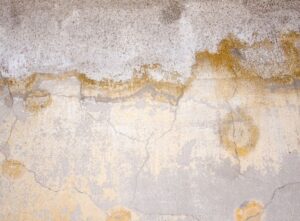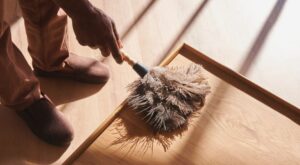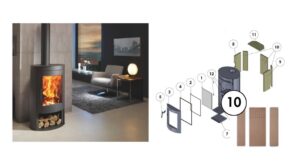
Although we enjoy the warmth of the fireplace, the odors can be unpleasant. With simple tricks like vinegar, salt, or baking soda, you can keep your home fresh and cozy.

There are things you don’t notice until suddenly… they’re there. A stain you don’t remember, a strange smell coming from some forgotten corner, a sense that something’s just not right with your furniture, your doors—or even the firewood stored near your wood-burning stove.
Mold on wood is one of those silent problems that shows up without warning. It doesn’t make a sound, but over time it can damage both your belongings and the atmosphere of your home. And it doesn’t matter whether you live in a mountain house, a rainy region, or near the sea: all it takes is a little moisture and poor ventilation for mold to find the perfect place to settle.
In fact, it’s very common for mold to appear in areas where there are wood-burning stoves, since improperly stored firewood or poor air circulation can create the ideal environment for it to grow. Many families discover it during day-to-day moments—when moving a chair, opening a cabinet, or lighting the wood-burning stove and noticing the firewood smells off.
That’s when the questions begin: How do I clean this without damaging the wood? Is it dangerous to my health? What if it comes back?
This article is for you. We’ll walk you through, step by step, how to remove mold from wood safely, using home remedies and easily accessible products. But more than that, we’ll also share tips to prevent mold from coming back—protecting both your home and your peace of mind.
You don’t need to be an expert or spend a fortune. Just a little care, the right materials, and this practical guide. Let’s help you restore your wood to its natural, fresh, mold-free state.
Mold forms when there’s moisture, warmth, and poor ventilation. Because wood is porous, it easily absorbs moisture from the air, making it the perfect breeding ground for fungi and spores. This happens especially in humid or coastal climates, during rainy seasons, or when we store wood or furniture near a heat source like a wood-burning stove under unsuitable conditions.
A poorly placed wood-burning stove, combined with damp firewood or improper storage, can increase condensation and, therefore, the appearance of mold on both the wood and the surrounding area.
Yes—mold not only damages wood but can seriously affect your health. Mold spores float in the air and can cause allergies, coughing, respiratory issues, and even headaches. It’s especially concerning for children, the elderly, and people with asthma or allergies.
Also, in spaces where wood-burning stoves are used, keeping firewood clean and dry is essential—not only for health reasons, but also to ensure efficient and safe combustion.

It’s not hard to detect mold if you know what to look for:
Dark, green, or white spots on the surface of the wood
Fuzzy or dusty textures that return after wiping
A musty, “closed-in” smell, even if everything looks clean
Surfaces that feel sticky or have a slightly gritty layer
If you notice any of these signs, it’s time to take action. These symptoms commonly appear on wooden items near wood-burning stoves, such as benches, firewood baskets, window frames, or shelves.
A family living in a humid inland region near a lake had a wood-burning stove in their living room. During the winter, they stored firewood inside the house against a wall. Over time, they noticed an unpleasant odor and dark stains at the base of the wall and on the firewood.
After some research, they realized that the combination of environmental humidity, heat from the wood-burning stove, and poor ventilation had encouraged mold growth. The solution? They removed the affected firewood, cleaned it with vinegar, ventilated the space better, and moved the firewood storage to a drier, airier spot. Since then, mold hasn’t returned, and their wood-burning stove now works better with clean, dry wood.
Before starting, protect yourself. Wear gloves and a mask to avoid breathing in spores. If the affected item is small or it’s firewood, move it outdoors. Open doors and windows to increase airflow.
Use a dry cloth to carefully wipe away surface mold. Don’t scrub too hard, as that can spread the spores.
White vinegar is a powerful natural fungicide. Mix one part vinegar with three parts warm water. Dampen a clean cloth or sponge and wipe the affected areas. Let it sit for at least 15 minutes. If mold persists, scrub gently with a soft brush, being careful not to damage the wood.
This method is perfect for cleaning decorative wood around your wood-burning stove or for treating the base where you store firewood indoors.
In addition to vinegar, you can use:
Baking soda – neutralizes odors and fights fungi
Hydrogen peroxide – deeply disinfects
Isopropyl alcohol – fast and effective on small surfaces
Always test any product on a small, hidden area before applying it to the whole surface.
After cleaning, make sure the wood dries completely. If possible, place it in the sun. If that’s not feasible, use a fan or dehumidifier to eliminate remaining moisture. This step is essential to prevent mold from returning—especially in areas where firewood is stored near the wood-burning stove.

Even when mold is gone, the smell can linger. Try these natural solutions:
Sprinkle baking soda on the surface and let it sit overnight
Place a container of activated charcoal or dry coffee grounds nearby
Ventilate the area for several days, letting air and sunlight do their job
Mold odor can soak into firewood if it’s been stored poorly. If your wood-burning stove gives off a strange smell when lit, the firewood might have absorbed moisture.
Store firewood in a dry, covered, well-ventilated area
Keep it off the ground and away from walls
Use a moisture meter and ensure your firewood is below 20% humidity
Dry wood not only prevents mold—it also improves your wood-burning stove’s performance, producing more heat and less smoke.
Inspect furniture and walls near your wood-burning stove or other heat sources
Use dehumidifiers in very humid rooms
Apply natural wood sealers to protect against moisture
If your wood-burning stove is in a damp area like a basement or ground floor, make sure the surrounding environment is well ventilated. A warm but poorly ventilated space can accelerate mold growth.
At Panadero, we don’t just design high-quality, high-performance wood-burning stoves. We care about everything around them: the wood details, the firewood baskets, the furniture that makes your house a home.
A well-maintained wood-burning stove starts with a clean, healthy environment. That’s why we’re sharing this practical, natural guide to help you eliminate mold and keep your space spotless. Because true warmth isn’t only about temperature—it’s about well-being.
Discover our collection at www.panadero.com. And if you have questions about caring for your wood-burning stove or storing firewood properly, we’re here to help.

Although we enjoy the warmth of the fireplace, the odors can be unpleasant. With simple tricks like vinegar, salt, or baking soda, you can keep your home fresh and cozy.

How to avoid dust in the house when using a wood stove: tips and tricks for a clean and healthy home

Learn how to remove mould from your wood for use by following the steps in this article.

All you need to know: what it is, uses and benefits of wood stoves
To provide the best experiences, we use technologies such as cookies to store and/or access device information. Consenting to these technologies will allow us to process data such as browsing behavior or unique identifiers on this site. Not consenting or withdrawing consent may adversely affect certain features and functions.